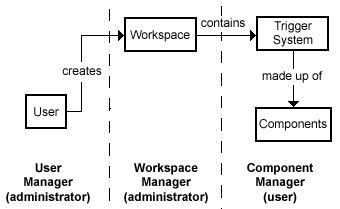The administrator creates workspaces, which hold the trigger systems (rules) that business users enter into the system. Workspaces provide a way to test and experiment with trigger systems. When a workspace is considered ready to be put online, it is promoted to pub, the production workspace. An administrator can create as many workspaces as needed.
A workspace contains trigger systems. A trigger system represents a business rule. Here is an example of business logic that could be represented in a trigger system:
The trigger system is made of components. A component uses other components as building blocks to create complex decision systems that read and operate on data from the transaction files and databases defined as data sources for the application. There are several different types of components, and they function in very different ways. For more information about creating components and developing trigger systems, refer to the
Detect User Guide.
